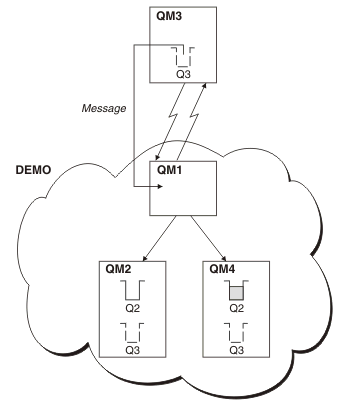Configuring workload balancing from outside a cluster
Configure a message path from a queue manager outside a cluster to any copy of a cluster queue. The result is to workload balance requests from outside the cluster to each instance of a cluster queue.
Before you begin
About this task
In this scenario, the queue manager outside the cluster, QM3 in Figure 1, sends requests to the queue Q2. Q2 is
hosted on two queue managers within cluster DEMO to
use workload balancing. A queue named Q2 is defined
on the queue managers QM2 and QM4 but
not on the gateway queue manager QM1. The requests
from QM3, the queue manager outside the cluster,
are sent to either instance of Q2.
QM3 is
not part of a cluster and communicates using distributed queuing techniques.
It must have a sender-channel and a transmission queue to QM1. QM1 needs
a corresponding receiver-channel. The channels and transmission queues
are not shown explicitly in Figure 1.
The procedure extends the example in Figure 1 in Configuring request/reply to a cluster.
Procedure
Results

When an application at QM3 issues an MQPUT call
to put a message to Q2, the QREMOTE definition
causes the message to be routed through the gateway queue manager QM1. QM1 uses
workload balancing to distribute messages targeted to Q2 between
the queues called Q2 on the two queue managers, QM2 and QM4,
which have cluster queue manager aliases for Q3.